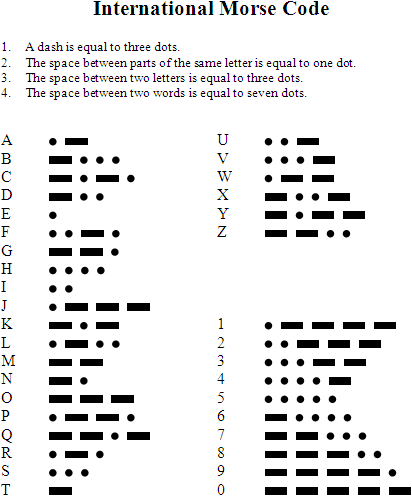
Morse Code Chart
Created by Samuel Morse in 1844, Morse Code can be sent at great speeds over telegraphs. 166 years later, Morse Code is still used today – mainly by ham radio operators. It can also be useful for emergency communications. Morse Code can be sent with a mirror, a flashlight, or a radio, and you can probably send Morse Code faster than you can send a text message!
Here’s how to get started learning Morse Code.
1. Start listening to Morse Code.
When you listen to Morse Code, what you hear is a series of long and short beeps – more commonly referred to as a “dit” (short) or a “dah” (long). Every letter is separated by a short pause, and every word is separated with a longer pause.
Hint: You can find an online Morse Code translator, search around for practice recordings, or buy a shortwave receiver to listen to some real Morse Code.
You can search or shop for practice recordings, or use a shortwave receiver to listen to the real thing. Some people use the Farnsworth method, which entails listening to Morse code characters at high speeds but with long spaces in between; as you become more proficient, the spacing is reduced.
2. Study a visual copy of the Morse Code alphabet.
A visual chart like the one seen here can certainly help. Try writing down the Morse Code alphabet by hand, and then writing sentences with it. This is one of the best ways to learn Morse Code fast. Once you memorize the Morse Code alphabet, its then an easy task to translate what you heard into what you saw visually. Like anything else worth doing, it takes practice!
3. Practice!
Translating Morse Code is a skill that just about any person can learn, but it absolutely takes practice. When you first start, you can write it down and sound it out, but eventually you’ll need to just hear it. The words “Learn Morse Code” are seen here:
.-.. . .- .-. -. – — .-. … . -.-. — -.. .
4. Transmit often!
One thing that you need to get used to is actually transmitting your Morse Code into audible signals. You can practice with the buttons on a mobile phone, beep vocally, or buy a Morse Code trainer. Whatever works best with you and your budget! To speak Morse Code while you learn, a small sound is pronounced “dit” and a long sound is pronounced “dah.”
5. To Learn Morse Code, don’t bite off more than you can chew.
Start learning Morse Code by memorizing the easiest letters first. One dit is an (E) and one dah is a (T). An (M) is “dah-dah” and an (I) is “dit-dit.” Leave the more complex letters for last, like a J, a B, an L and an F (which I still get confused upon!)
6. Invite your friends!
Learn Morse Code, and then spread it around to your friends! You can then communicate with Morse Code through blinking your eyes, a flashlight, a mirror, or even by tapping your fingers at the dinner table!
